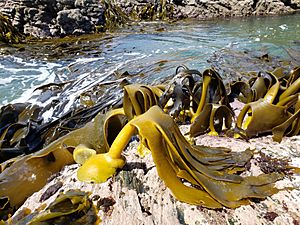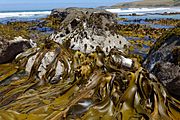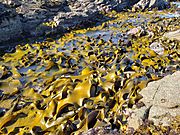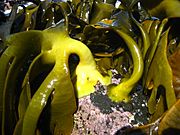Durvillaea poha facts for kids
Quick facts for kids Durvillaea poha |
|
|---|---|
 |
|
| Durvillaea poha in foreground (with D. willana below) at Brighton Beach, Otago | |
| Scientific classification |
Durvillaea poha is a type of large, strong bull kelp that grows in New Zealand. It is a special kind of seaweed found along the coasts. This kelp is known for its wide, air-filled blades. It plays an important role in its ocean home. People, especially the Māori, have also used it for many years.
Contents
Discovering Durvillaea Poha
Scientists first thought Durvillaea poha was just a different form of another kelp, Durvillaea antarctica. But in 2012, they looked closer. They studied its genes, how it looked, and where it grew. They found it was different enough to be its own species.
In southern New Zealand, you might see both D. poha and D. antarctica growing together. However, D. poha usually grows a bit higher on the rocks. It also prefers more sheltered bays. This means it grows where the ocean waves are not as strong. D. poha also tends to have wider blades than D. antarctica. Its blades can sometimes look more orange.
What's in a Name?
The name poha comes from the Māori word "pōhā". These are special storage bags. Māori people traditionally made these bags from kelp blades. So, the name of the kelp honors this important cultural use.
What Does It Look Like?
Durvillaea poha has wide, flat blades. These blades are filled with air. This makes them look like a "honeycomb" inside. This structure helps the kelp float. The kelp also has thick, pale, or orange stems called stipes. These stipes are usually not branched.
- Images of Durvillaea poha
Where Does It Live?
This special kelp is found only in certain places. It lives on the South Island of New Zealand. You can also find it on the subantarctic Snares and Auckland Islands. When a species is found only in one area, it is called endemic.
How People Use Durvillaea Poha
Traditional Māori Uses
The blades of D. poha are very important to Māori culture. Along with D. antarctica, its blades are used to make traditional pōhā bags. These bags are very useful. They are used to carry and store food and fresh water. They can also help keep live shellfish fresh. Māori also used them to make clothing and gear for sports.
Pōhā bags are especially important to the Ngāi Tahu people. They often use them to carry and store muttonbird (tītī) chicks. These chicks are a traditional food source. The kelp bags help keep them safe and preserved.





